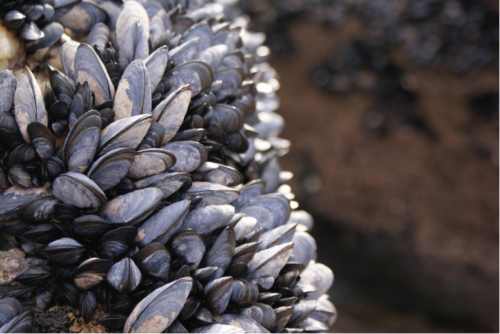Image courtesy of Flickr.
What do mussels have that we humans don’t? Well, many things, but among them: the ability to stick to surfaces underwater.
Strong underwater adhesives have versatile and useful real-world applications ranging from underwater equipment repair to surgical glue. Researchers from the Washington University in St. Louis combined mussel foot proteins and spider silk to create a hydrogel that is able to adhere to surfaces underwater. “Nature already offers a wealth of materials, and some of them even outperform synthetic materials,” said Professor Fuzhong Zhang, a lead researcher on the study. The mussel foot proteins naturally secreted by mussels allow them to adhere to a variety of surfaces, even in the harsh conditions of seawater. “We’re inspired by natural materials that are very impressive in some aspects. The first step is trying to reproduce it. Once we are confident that we can synthesize the material with similar properties, then we can engineer it to make it perform better.” Zhang said.
And engineer it they did. The new adhesive hydrogel is able to stick to a wide range of surfaces — ranging from glass to mammalian tissues — underwater. The researchers began with the zipper-forming motif of an Aβ amyloid protein, which conveniently tends to self-assemble into stable nanofibrils. Then, they added spider silk protein for much-needed material strength, and mussel foot protein for improved surface adhesion. The final hybrid protein was produced by engineered microbes. This process, which pushes the boundaries of traditional recombinant DNA technology, presented unique challenges to the researchers. “The mussel protein contains a special amino acid, DOPA, which basically offsets Tyrosine. It’s not one of the 20 canonical amino acids. In our case, we have to engineer the bacteria so that it can incorporate DOPA into the protein with high efficiency.” Zhang said. The incorporation of non-canonical amino acids is critical to the function of these tri-hybrid proteins.
This microbial production of useful naturally-occurring materials has the advantage of allowing advanced, specific DNA control of functional groups. “Scientifically, the biggest challenge is to understand the sequence-property relationship of protein-based adhesives. With that knowledge, we will be able to create adhesives with desirable properties.” Zhang said. The researchers were able to fine-tune the properties of the hydrogel — structure, strength, cohesion, adhesion — by adjusting the different domains and sequences of spider silk and mussel foot proteins.
On a practical level, this novel hydrogel provides several advantages over pre-existing competitors in the field. Since the hydrogel is biocompatible and biodegradable, it is an attractive, unique candidate for tissue repair and surgical applications. Another feature is its mechanical similarity to collagen, a major structural element in the extracellular matrix. “It is critical for a surgical adhesive to have similar properties with the natural extracellular matrix because that can promote more rapid tissue repair and reduce the chance of failure.” Zhang said. The hydrogel is also protein-based, as opposed to other previously developed polymer-based adhesives. One area in which a protein-based adhesive is necessary is coral restoration, where the adhesive must not only work well underwater, but also not release any potentially toxic materials.
This project is an exciting example of the potential of synthetic biology. Zhang reminisced on the team’s first, unexpected encounter with the possibilities of mussel foot protein. “A few years ago, one of my graduate students, Eugene Kim (who is now an Assistant Professor at George Mason University), worked on this project. At that time, the adhesive protein he made looked the same as any other protein — it was just a powder that would dissolve in solution.” Zhang said. Kim didn’t test the proteins underwater — he simply added some protein solution between two aluminum bars. “The next day when he tried to pull, it was so strong he could not pull it apart. And he’s a strong guy!” Even before officially testing the material, the researchers found that it was strong enough to lift a full one-liter bottle of water despite only having a tiny area of adhesion.
Synthetic biology is a rapidly growing field, full of innovation and growth. “I want people to learn more about the opportunity that synthetic biology provides to material science and material engineering. We would like to work with many researchers who believe in the power of synthetic biology. We welcome new students to join us and explore this exciting field together.” Zhang said.

